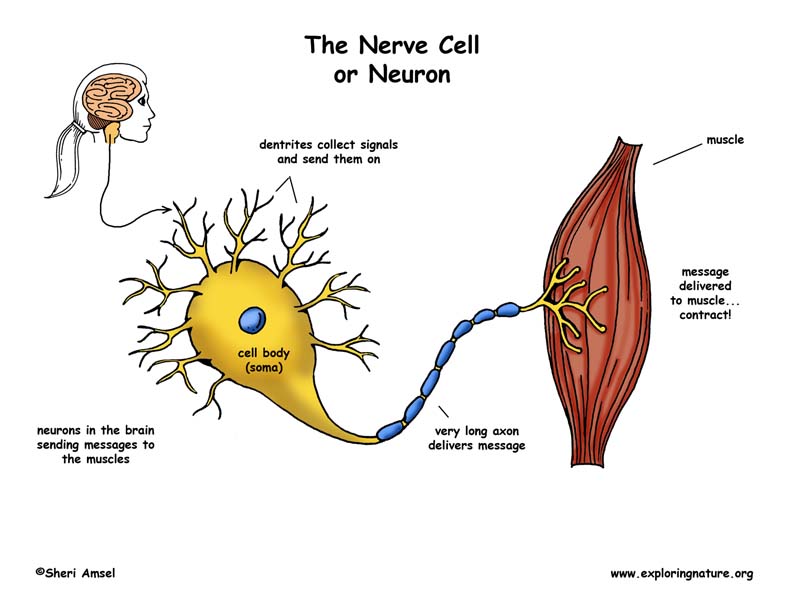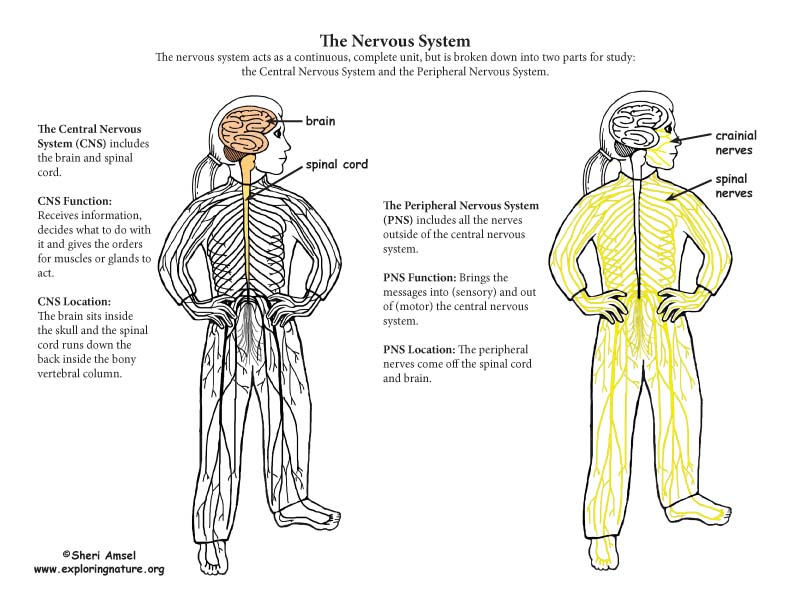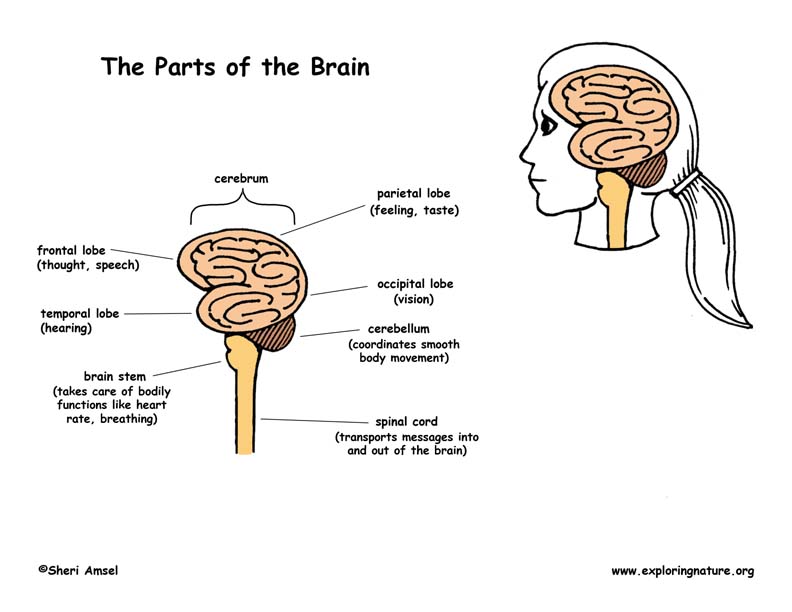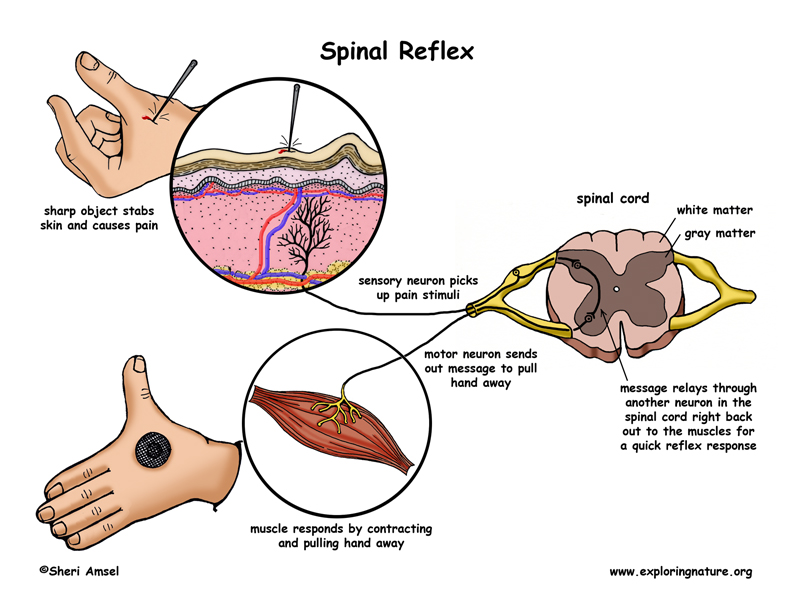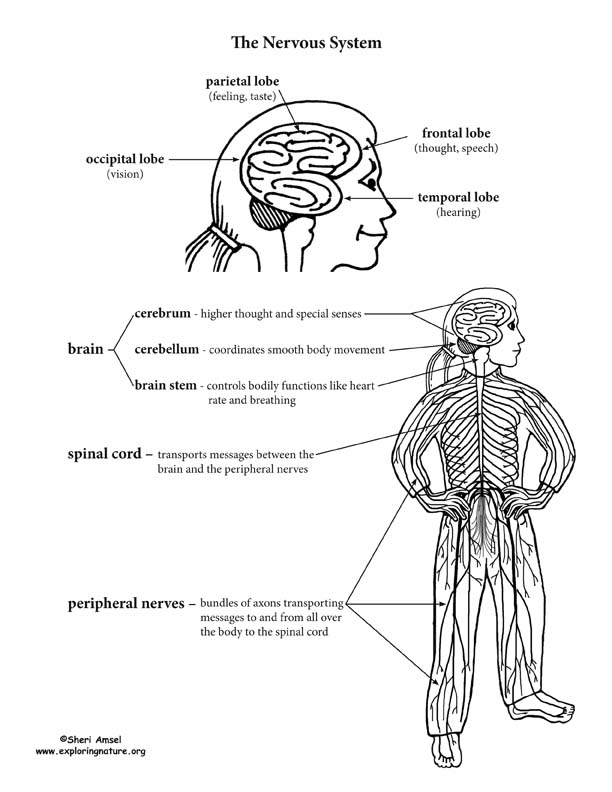

Of all the body’s systems, the Nervous System is the “brains” of the outfit. It controls how all the other systems work in a huge communication network. A bit like the internet, the nervous system has messages coming in and going out every second of the day and night. It keeps track of everything going on in the body to make it run smoothly. It keeps everything in balance or in homeostasis. To do this, the nervous system’s messages have to be as fast as lightening. Like lightening, the messages throughout the nervous system are actually electrical signals.
The Nervous System has three jobs:
1) It receives information (or stimulus) from the outside world and brings it into the body. Millions of tiny nerve cells sense the stimuli. They are called sensory receptors. The stimulus is called sensory input. If you walk outside and see the sun shining, smell the flowers blooming, and hear the birds singing, you have gotten three kinds of sensory input. Those are just the three stimuli that are the most obvious that you notice right away though. In truth, your brain is getting sensory input from all kinds of body sensors all the time. You will know when you get hot, cold, hungry, thirsty, sleepy, sore, or itchy. You will be able to tell when you are lying down, standing up, falling, get stung by a wasp or scratched by a bush, because your brain gets the stimulus and tells you what it is.
2) This brings us to the second chore that the nervous system does. It decides what to do with all that sensory input. This is called integration, because it integrates or brings together the stimulus with what you are going to do about it. Your brain puts together sun shining, flowers blooming and birds singing and tells you – breath deep, smile and feel happy!
3) The third chore is triggering action. This is called motor response or motor output. Your muscles respond to orders. You skip down the road, breath deep and hum along with the birds. You can think of it like the motor of a car making the car move. Motor means action.
The Parts of the Nervous System
All those messages coming into and out of the brain are carried by nerve cells. Nerve cells (or neurons) carry nerve impulses – like an electrical cord carries an electrical signal. Nerve cells receive information through thousands of tiny finger-like projection, called dendrites. They deliver all the information into the body of the nerve cell. They also have a very, very long tail called an axon. The axon carries the message to its destination. These axons are smaller than the tiniest thread but travel together all over the body grouped together in bundles called nerves. You have thousands of nerves running signals all over your body all the time. The nerves then branch into smaller and smaller pathways to pick up and drop off their messages to every inch of body.
For example, when you step outside, the bright sunlight enters your eyes. The message goes to your brain, and in a split second, the signal comes back to your iris to contract and the muscles of your eye to squint. This quick action protects your eyes from getting too much light.
Every nerve is like a message highway with many lanes. Each lane is one nerve cell axon that carries messages at high speed to their destination. There are millions of nerve cells working all the time and bundled together into nerves. They branch off and exit when they reach their destination. The messages are then delivered through those tiny dendrites to the muscle or gland that need to act.
Passing on the Message
If a message has to go really far in the body (think about a strand thinner than a hair stretching between your brain and big toe) it sometimes takes two nerve cells to get it there. The first nerve cell will bring the message in through its dendrites and pass it to the next nerve cell. Then that nerve cell sends the message down its long axon to its final destination. The tiny space between the two nerve cells or the tiny space between the nerve cell and its target muscle is called a synapse. Instead of that electrical message jumping across this little gap or synapse, it triggers a chemical to squirt across and deliver the final message. This happens very fast. The chemical messenger is called a neurotransmitter.
The Two Parts of the Nervous System
The nervous system is made up of the brain, the spinal cord and all the nerves that run between your brain and spinal cord. Even though they are all together, anatomists break down the nervous system into two parts – the central nervous system and the peripheral nervous system.
The central nervous system (CNS) is the brain and the spinal cord – which runs down your back inside the bony vertebral column. The CNS receives the information, decides what to do with it and gives the orders.
The peripheral nervous system (PNS) is all the nerves outside the cerebral nervous system. That includes the nerves coming off the spinal cord and brain – the spinal nerves and cranial nerves.
The Central Nervous System
The Brain
The average brain weighs less than 4 pounds. It is soft and pink and wrinkled like a walnut. The brain has three major parts – the cerebrum, the cerebellum and the brain stem. The brain is shaped like a mushroom with the brain stem as the stalk and the cerebrum as the cap of the mushroom drooping down and closing over the top of the stalk. The cerebellum sits in back inside and under the cap. The cerebrum is the largest part of the brain. It makes up about 85%. It has two matching sides, or hemispheres, that are connected in the middle. Again, it looks like the inside of a walnut. Like a walnut it is also covered with twisting ridges and grooves.
The Cerebrum
The cerebrum is different on the outside than it is on the inside. It has an outer layer, like the bark of a tree that is called the cerebral cortex and is gray in color, so is also called the gray matter. The gray matter is where all the nerve cell bodies are found. The inner part of the cerebrum is mostly white. This is where all the nerve cell axons run from the cell bodies (in the gray matter) down through the spinal cord on their way to other parts of the body.
The brain is not just about how smart you are. It also contains your entire personality and memories. The gray matter in the cerebrum is where the human personality lives. This part of your brain allows you talk, listen and understand what people are saying to you. It lets you remember what you had for breakfast this morning or did for your birthday last year. It is where you understand things around you like heat, cold, smells, and sights, and where you decide what to do about them. For example, if you suddenly realized that you smelled smoke, you might wonder for a few seconds what it was, but then you would understand and spring into action. You would jump up to see where it was coming from and if there was a fire you needed to put out or escape from. This is what your gray matter – your cerebral cortex – does for you.
The Cerebellum
The cerebellum is a small, rounded part of the brain found in the back underneath the bulging of the cerebrum. It is only about a tenth of the brain, but a very important. Its job is to coordinate all your movements without you even thinking about it. Like an engine with many moving parts, the cerebellum helps your body put together balance and movement with what you need to do. Think of all the muscles, nerves and senses you need just to walk up the stairs. Now how about playing soccer? If your cerebellum was injured in an accident, every step you take would be jerky and difficult. Your cerebellum keeps you running like a well-oiled machine with many moving parts.
The Brain Stem
The brain stem’s job is to quietly take care of important bodily functions that we don’t think about - like heart rate, breathing, and even coughing. All the messages to and from the brain and body must also pass through the brain stem.
The Spinal Cord
The spinal cord runs from the brain down the back inside the protective vertebral column. It is made up of the very long, thin axons of thousands and thousands of nerve cells bringing their messages to and from the brain and body.
If the spinal cord is injured or broken, none of those important messages can get through to or from the brain. Your body below the break in the cord cannot send signals to the brain, so you don’t feel anything from that part of the body anymore. Your body below the break in the cord also cannot receive signals from the brain, so you can’t move that part of the body any more. This is called paralysis and can be permanent.
Protection of the CNS
The brain and spinal cord are surrounded and protected by tough layers of tissue called the meninges. There is a cushion of fluid between the brain and spinal cord and the meninges in which they float. This protects them from being banged around when you run and jump. If your brain does get banged, it is called a concussion. This can make you feel dizzy and even pass out. A bad concussion can do damage to your brain.
It is very important to protect the brain from injury. That is why we use bike helmets and wear seatbelts in the car. We only have one brain. As we age our blood vessels (arteries and veins) get more brittle and full of plaque. Sometimes a blood vessel in the brain gets blocked or breaks open and the blood carrying oxygen cannot get to the brain. This is called a stroke where the starved part of the brain can actually die. Since your brain controls everything that you do, this would leave some things not working – like speech or walking.
The Peripheral Nervous System
The peripheral nervous system links the rest of your body to the spinal cord and brain. It does this with two jobs.
1) The first is bringing information in – the sensory input. The nerves deliver the sensory input to the central nervous system (the spinal cord and brain). When walk outside and see the sunlight that information is coming in through nerves to your brain. The same with the smell of flowers and the sound of birds singing – smell and sound are picked up by nerves and brought to your brain, which makes sense of them for you.
The peripheral nervous system brings in messages from all over your body – from your skin, muscles, joints and even your internal organs. If you eat too much food, you know it because you feel full. You know this because the peripheral nerves are giving that message to your brain and your brain says – no more French fries!
If you injure a peripheral nerve in your arm or leg, you may get some paralysis from that spot to the end of for fingers or toes for a while until the nerve grows back. Nerves grow very, very slowly though, so it may take a while. Scientists estimate that it can take as long as a month for every inch below the injury for nerve axons to grow back before you are all better.
2) The second job of the peripheral nervous system is to carry signals out – the motor output. If the brain wants to tell the muscles to move, it sends the signal out through the peripheral nerves to those muscles and you move it. If you have even had to chase the soccer ball down the field, it is the nerves in your peripheral nervous system that get the message from your brain and tell your legs to start running.
You don’t control all of the motor output of your peripheral nervous system. Some happens through the involuntary nervous system. Wave to a friend. You just controlled both voluntary muscles and voluntary nervous system motor signals.
But if you have ever had a friend grab you from behind or seen an angry dog rush up to a fence to bark at you, you might gasp and jump without thinking about making that action happen. This is your involuntary nervous system at work. It controls all your everyday actions like heartbeat and digestion, but it also can give you a jolt of action in an emergency. This is called the fight or flight response and can save your life.
Reflexes
Sometimes messages coming into the nervous system need a very quick response. Think about how fast you move when you touch a hot stove. That message never even had time to reach your brain. It just arched around through the spinal cord to give a quicker response. This is called a spinal reflex. This is an important response to emergency moment when your body needs to respond quicker than the brain can act.
When you research information you must cite the reference. Citing for websites is different from citing from books, magazines and periodicals. The style of citing shown here is from the MLA Style Citations (Modern Language Association).
When citing a WEBSITE the general format is as follows.
Author Last Name, First Name(s). "Title: Subtitle of Part of Web Page, if appropriate." Title: Subtitle: Section of Page if appropriate. Sponsoring/Publishing Agency, If Given. Additional significant descriptive information. Date of Electronic Publication or other Date, such as Last Updated. Day Month Year of access < URL >.
Amsel, Sheri. "Nervous System Structures and Function" Exploring Nature Educational Resource ©2005-2024. December 13, 2024
< http://mail.exploringnature.org/db/view/1060 >


